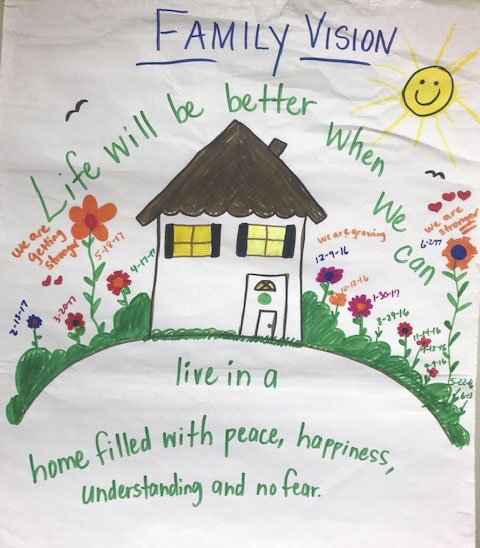Linda Williams, wraparound team lead for Continuum of Care Region B in the Upstate, has developed a unique way of connecting with her families and showing the progress they are making on their High Fidelity Wraparound journey.
High Fidelity Wraparound asks each family to work together to create a "Family Vision" statement that expresses who their family is, their combined hopes and dreams, and the goals they are striving for by reflecting on the phrase, 'Life will be better when….'
However, Williams uses interactive art to take the process to the next level, helping families visualize how far they've come.
"After meeting with the family and getting their family vision statement, I draw a house on a large post-it paper and write their family vision on it. I then begin to engage the family to look at their house and reflect on what they can do as a family to make their vision come to life," says Williams. "At this point, families sometimes are at a loss and in so much disarray that they can’t see what their family can become.
"But during monthly meetings they review their statement and rate how well they are doing. The youth draw a flower in their garden to reflect good progress, and over time, they can see how far they have come by the many flowers in the garden."
Williams says the idea came to her several years ago while working with an 11-year-old girl and her guardian grandparents who were avid gardeners.
"The grandparents would always tell their granddaughter how much they loved her. They called her 'Belle,' a term of endearment for beautiful flowers, and eventually she began to believe in herself and that she was also a beautiful flower," says Williams. "Flowers were such a strong connection between the grandparents and the youth, and seeing how she blossomed in their care made me want to incorporate that imagery for my other families."
Greg Wright, who leads the Continuum of Care division, says he encourages initiatives like this that help facilitators personalize the care they provide to each family. “All of our staff have their own methods of meeting families where they are and individualizing the treatments to find what works best,” he says. “Linda is a very creative person, and she has found a great way to provide Wraparound services that meet the needs of her youth and families.”
The technique has been successfully used by others in the division, including Alisha Kammerude, a wraparound facilitator who started using it last September with support from Williams. "My families have really enjoyed this tool as I bring it every month to display how our flowers have grown since our initial meeting. The visuals help my youth see where they started in the wraparound process and encourages them to want to continue to work on their underlying needs in order to add more flowers to their garden."
Williams says she frames the resulting artwork and presents it to the family once youth have successfully completed the Wraparound program as a lasting reminder of their shared goals and how far they have come.
"I hope when they look at it, they see that what was once just a house is now surrounded by beauty and has become a welcoming home."
